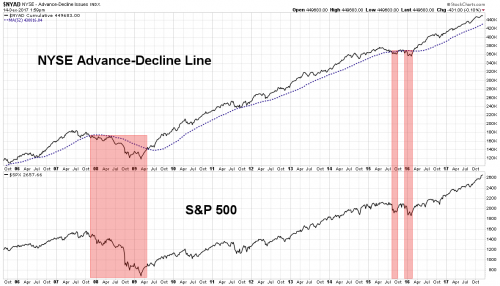There’s no denying that 2017 has been a good year for investors, with most major asset classes showing gains for the year.
This time on Financial Sense Newshour, we spoke with Louise Yamada of LY Advisors about current conditions and whether she sees any signs of a market top or concerning developments.
Are We on Track for Longest Recovery?
Everything looks to be in alignment and going in one direction, and we’re already in the ninth year of this current bull market.
The cumulative advance-decline line has been confirming the rally, Yamada noted. It has been hitting new highs along with the major indexes.

Source: Stockcharts.com
Minimal Signs of Stress
On the Dow, there were some prior concerns because the Transports had been lagging the Industrials, but last week they experienced a strong breakout.
If you look at the Nasdaq, it’s behavior looks just like the Dow, consisting of a stepping stone pattern with higher lows and higher highs.
It is slightly extended above the 50-day moving average and the trendline off the 2016 low, Yamada noted, but the Nasdaq may just be going into another consolidation period, as it did from June to October.
The only really concerning issue is the new highs we’re seeing in margin debt, Yamada noted, which are at the highest levels we’ve ever seen.

Source: Advisor Perspectives
“If we were to get some kind of a serious decline, we’d have an awful lot of margin calls coming in,” Yamada said.
Overall, however, given the technical backdrop, we’re probably on track for a continuation of the bull market from here.
Transition in Interest Rates
We’re in a transition from a falling interest rate cycle to a rising interest rate cycle, Yamada stated, and these cycles typically last from 22 to 37 years. The current falling interest rate cycle has lasted for 36 years.
“If you look at the 2-year (Treasury), you’ve got a 9-year saucer bottom,” Yamada said. “That’s characteristic of the transitions from falling to rising rates, because all of those periods have encountered deflationary pressure, and it takes time to get out of them.”













Leave A Comment